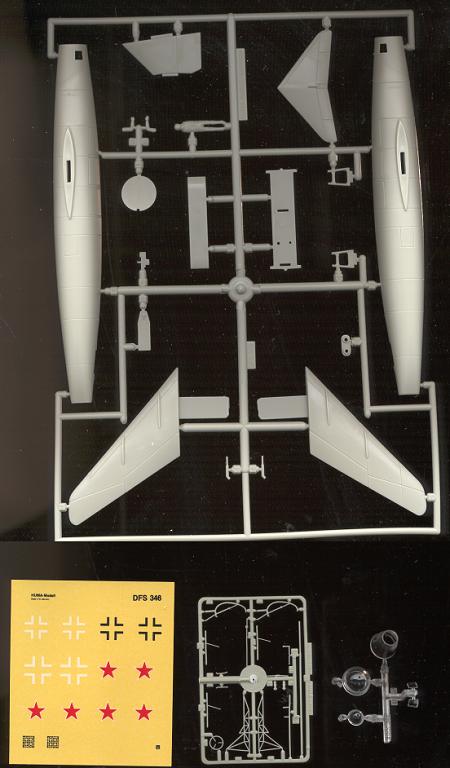
|
KIT: |
Huma 1/72 DFS-346 |
|
KIT # |
4002 |
|
PRICE: |
$29.98 |
|
DECALS: |
Two versions: Generic German and Russian |
|
REVIEW BY: |
|
|
NOTES: |
No swastika |

|
HISTORY |
A 1943/44 study for an experimental supersonic research aircraft was undertaken by DFS (the German Research Institute for Gliding). Designed for an altitude of 100,000 feet at speeds of near 1,000 miles an hour, an aircraft of all metal construction was envisioned. There was also a need to provide a pressurized cockpit and to keep the airframe as clean as possible. This led to the pilot being in the prone position and the nose being made of clear glass. In fact, there were two clear sections. The outer windscreen and an inner section that was part of the pressurized pilot's compartment.
Since the aircraft would be unable to reach operational altitude from the ground, it would have to be carried as part of a Mistel composite aircraft to approximately 30,000 feet prior to launch. Landing was to be made on skids as retractable landing gear would have added too much weight. In order to allow the pilot some safety, the front section was held onto the rear by explosive bolts. Should an emergency arise, the nose section was a safety capsule whereon the pilot was then ejected at a safe altitude to parachute down to safety.
Power was to be by two Walter HWK 109-509 engines of 2,000 lbs thrust; similar to what was used with the Me-163/263 rocket interceptors.
It was widely believed that the aircraft existed and was searched for after the war by the Allies. However, no aircraft was found. Later in the 1960's, it was learned that the Russians had built and tested a 'Samoljet 346'. This is undoubtedly the DFS-346 built by German scientists under Russian supervision. Almost nothing is known about this aircraft, even today.
Had the aircraft gone into any kind of production, it would have made a superb reconnaissance platform. Its high speed and operating altitude would have made it invulnerable to interception.
|
THE KIT |

This particular Huma kit is one of the more recent releases. What really stands out is the super-fine plastic tree of small parts. It is, in my opinion, superior to the etched brass that other companies put in their kits. They are truly 3-D and you don't need to use superglue to attach the parts.
As you can see from the image to the right, there are about 40 parts; most of them clear or on the small sprue. Detail is finely engraved, and unlike their earlier kits, it is made of a grey, not white plastic. The plastic also seems harder than the older kits. The surface of the plastic has a slight 'pebbly' texture. Having built other kits with this texture, I can assure you that it will disappear under the first coats of paint.
The instruction sheet is six pages, with a very detailed history in German, English, and French. Two of the pages are history, two are construction and two are color and markings. Those pages are in color and very well done.
|
CONSTRUCTION |
|
PAINT & DECALS |
|
CONCLUSIONS |
|
REFERENCES |
Review copy courtesy of me and my wallet!! If any of you manufacturers or shop owners want to send products for review and building, please
contact me.